Devosa Resources: Comprehensive Business Development Plan Project
VerifiedAdded on 2020/10/15
|13
|2274
|82
Project
AI Summary
This project presents a comprehensive business development plan for Devosa Resources, a software development company based in Sydney, Australia. The plan begins with a business overview, highlighting the growth in the software industry and the company's mission to provide quality software solutions. It details the company's services, organizational structure, and key roles and responsibilities. The plan outlines development strategies, including marketing, career development, and change management, to ensure the company's growth and success. Furthermore, it provides a detailed implementation strategy that includes creating a dedicated team, establishing a shared vision, defining actionable goals, creating an action-oriented plan, valuing communication, and monitoring progress. This plan offers a strategic roadmap for Devosa Resources to achieve its goals and establish itself as a leader in the software development industry.
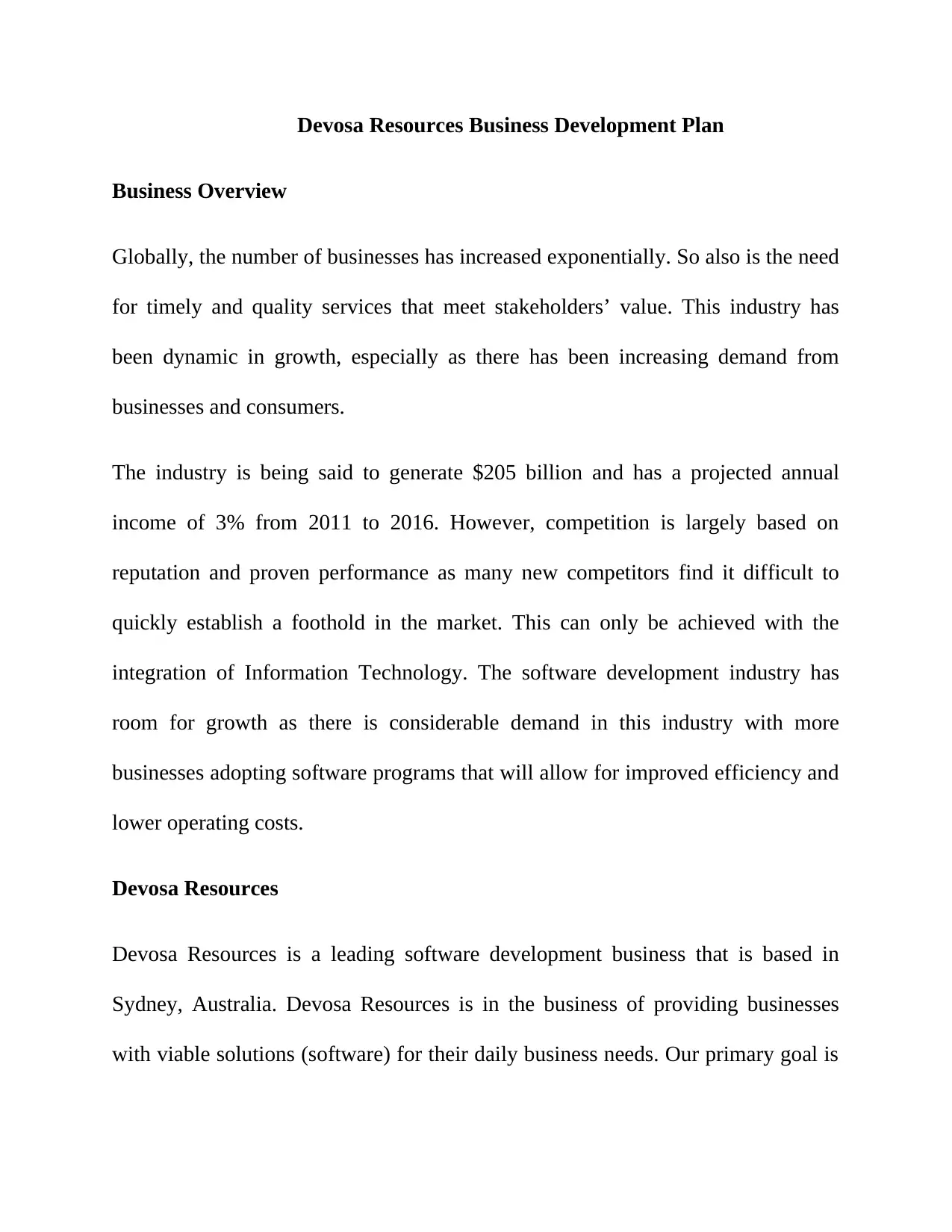
Devosa Resources Business Development Plan
Business Overview
Globally, the number of businesses has increased exponentially. So also is the need
for timely and quality services that meet stakeholders’ value. This industry has
been dynamic in growth, especially as there has been increasing demand from
businesses and consumers.
The industry is being said to generate $205 billion and has a projected annual
income of 3% from 2011 to 2016. However, competition is largely based on
reputation and proven performance as many new competitors find it difficult to
quickly establish a foothold in the market. This can only be achieved with the
integration of Information Technology. The software development industry has
room for growth as there is considerable demand in this industry with more
businesses adopting software programs that will allow for improved efficiency and
lower operating costs.
Devosa Resources
Devosa Resources is a leading software development business that is based in
Sydney, Australia. Devosa Resources is in the business of providing businesses
with viable solutions (software) for their daily business needs. Our primary goal is
Business Overview
Globally, the number of businesses has increased exponentially. So also is the need
for timely and quality services that meet stakeholders’ value. This industry has
been dynamic in growth, especially as there has been increasing demand from
businesses and consumers.
The industry is being said to generate $205 billion and has a projected annual
income of 3% from 2011 to 2016. However, competition is largely based on
reputation and proven performance as many new competitors find it difficult to
quickly establish a foothold in the market. This can only be achieved with the
integration of Information Technology. The software development industry has
room for growth as there is considerable demand in this industry with more
businesses adopting software programs that will allow for improved efficiency and
lower operating costs.
Devosa Resources
Devosa Resources is a leading software development business that is based in
Sydney, Australia. Devosa Resources is in the business of providing businesses
with viable solutions (software) for their daily business needs. Our primary goal is
Paraphrase This Document
Need a fresh take? Get an instant paraphrase of this document with our AI Paraphraser
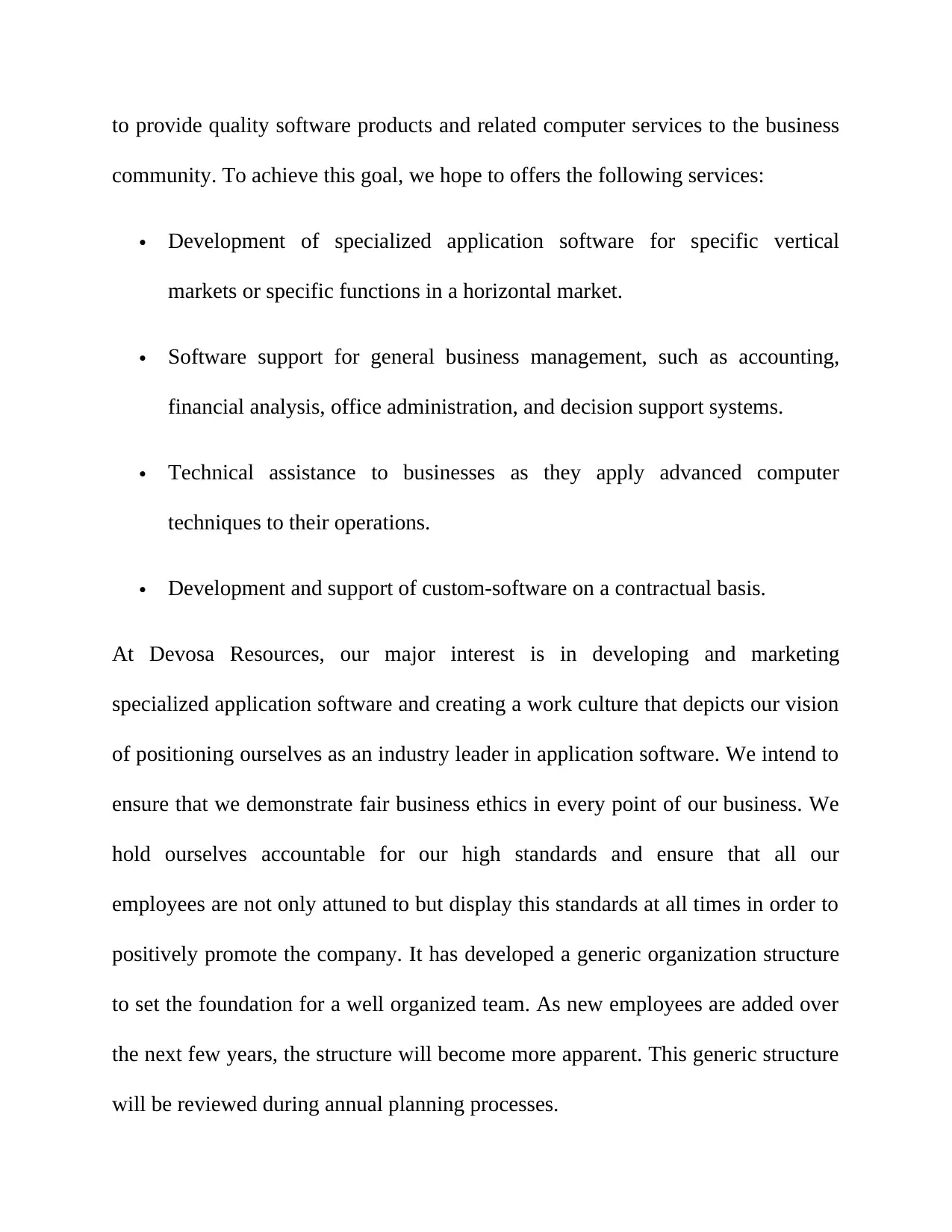
to provide quality software products and related computer services to the business
community. To achieve this goal, we hope to offers the following services:
Development of specialized application software for specific vertical
markets or specific functions in a horizontal market.
Software support for general business management, such as accounting,
financial analysis, office administration, and decision support systems.
Technical assistance to businesses as they apply advanced computer
techniques to their operations.
Development and support of custom-software on a contractual basis.
At Devosa Resources, our major interest is in developing and marketing
specialized application software and creating a work culture that depicts our vision
of positioning ourselves as an industry leader in application software. We intend to
ensure that we demonstrate fair business ethics in every point of our business. We
hold ourselves accountable for our high standards and ensure that all our
employees are not only attuned to but display this standards at all times in order to
positively promote the company. It has developed a generic organization structure
to set the foundation for a well organized team. As new employees are added over
the next few years, the structure will become more apparent. This generic structure
will be reviewed during annual planning processes.
community. To achieve this goal, we hope to offers the following services:
Development of specialized application software for specific vertical
markets or specific functions in a horizontal market.
Software support for general business management, such as accounting,
financial analysis, office administration, and decision support systems.
Technical assistance to businesses as they apply advanced computer
techniques to their operations.
Development and support of custom-software on a contractual basis.
At Devosa Resources, our major interest is in developing and marketing
specialized application software and creating a work culture that depicts our vision
of positioning ourselves as an industry leader in application software. We intend to
ensure that we demonstrate fair business ethics in every point of our business. We
hold ourselves accountable for our high standards and ensure that all our
employees are not only attuned to but display this standards at all times in order to
positively promote the company. It has developed a generic organization structure
to set the foundation for a well organized team. As new employees are added over
the next few years, the structure will become more apparent. This generic structure
will be reviewed during annual planning processes.
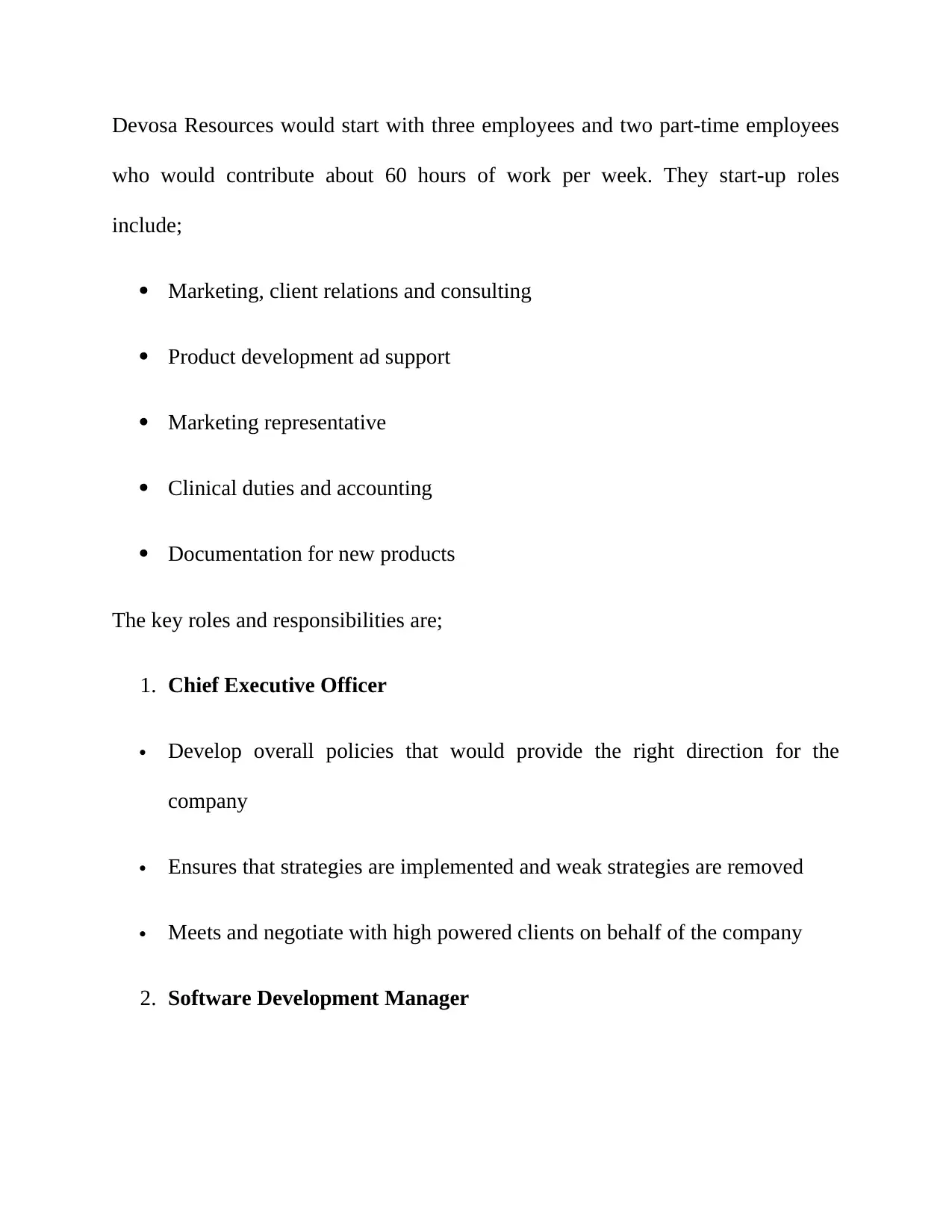
Devosa Resources would start with three employees and two part-time employees
who would contribute about 60 hours of work per week. They start-up roles
include;
Marketing, client relations and consulting
Product development ad support
Marketing representative
Clinical duties and accounting
Documentation for new products
The key roles and responsibilities are;
1. Chief Executive Officer
Develop overall policies that would provide the right direction for the
company
Ensures that strategies are implemented and weak strategies are removed
Meets and negotiate with high powered clients on behalf of the company
2. Software Development Manager
who would contribute about 60 hours of work per week. They start-up roles
include;
Marketing, client relations and consulting
Product development ad support
Marketing representative
Clinical duties and accounting
Documentation for new products
The key roles and responsibilities are;
1. Chief Executive Officer
Develop overall policies that would provide the right direction for the
company
Ensures that strategies are implemented and weak strategies are removed
Meets and negotiate with high powered clients on behalf of the company
2. Software Development Manager
⊘ This is a preview!⊘
Do you want full access?
Subscribe today to unlock all pages.

Trusted by 1+ million students worldwide
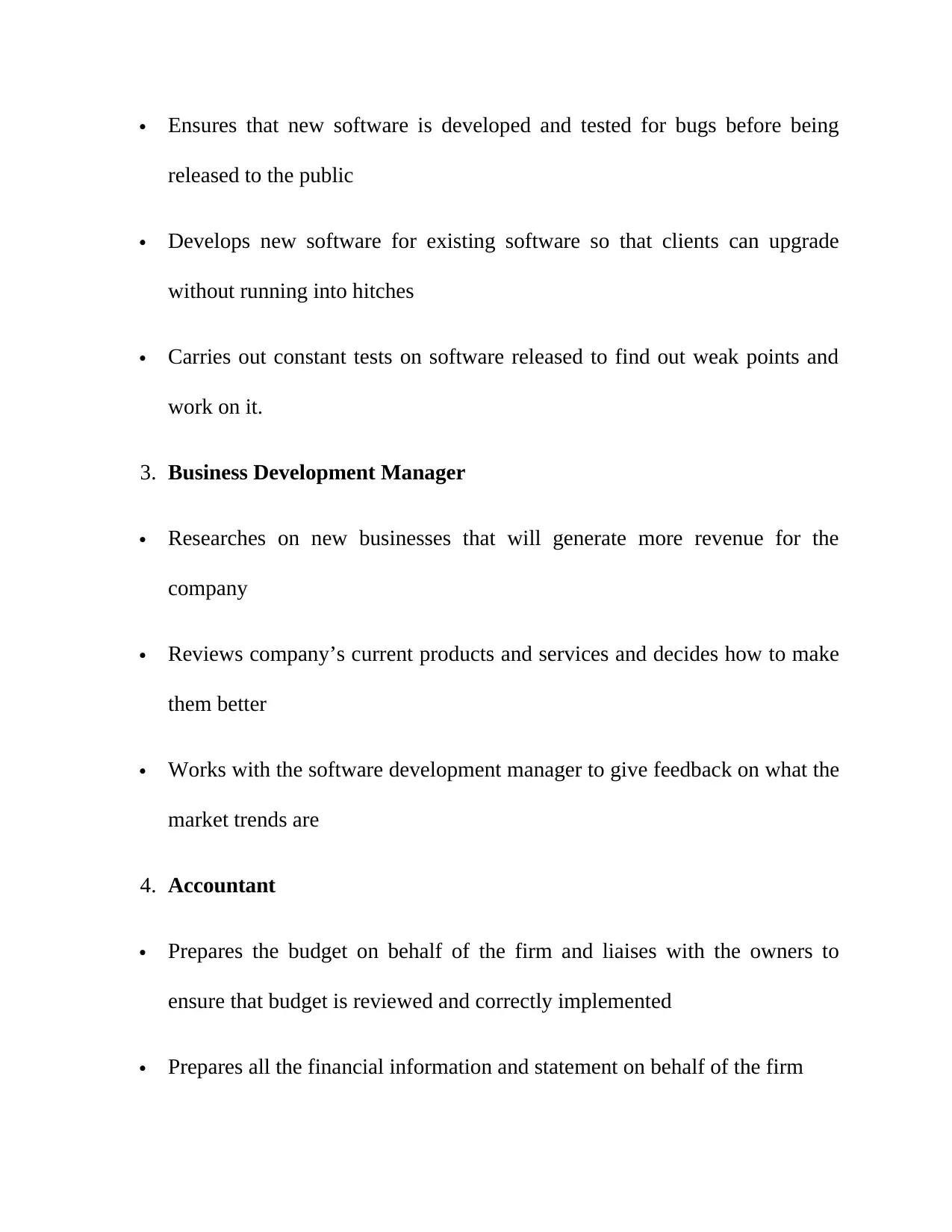
Ensures that new software is developed and tested for bugs before being
released to the public
Develops new software for existing software so that clients can upgrade
without running into hitches
Carries out constant tests on software released to find out weak points and
work on it.
3. Business Development Manager
Researches on new businesses that will generate more revenue for the
company
Reviews company’s current products and services and decides how to make
them better
Works with the software development manager to give feedback on what the
market trends are
4. Accountant
Prepares the budget on behalf of the firm and liaises with the owners to
ensure that budget is reviewed and correctly implemented
Prepares all the financial information and statement on behalf of the firm
released to the public
Develops new software for existing software so that clients can upgrade
without running into hitches
Carries out constant tests on software released to find out weak points and
work on it.
3. Business Development Manager
Researches on new businesses that will generate more revenue for the
company
Reviews company’s current products and services and decides how to make
them better
Works with the software development manager to give feedback on what the
market trends are
4. Accountant
Prepares the budget on behalf of the firm and liaises with the owners to
ensure that budget is reviewed and correctly implemented
Prepares all the financial information and statement on behalf of the firm
Paraphrase This Document
Need a fresh take? Get an instant paraphrase of this document with our AI Paraphraser
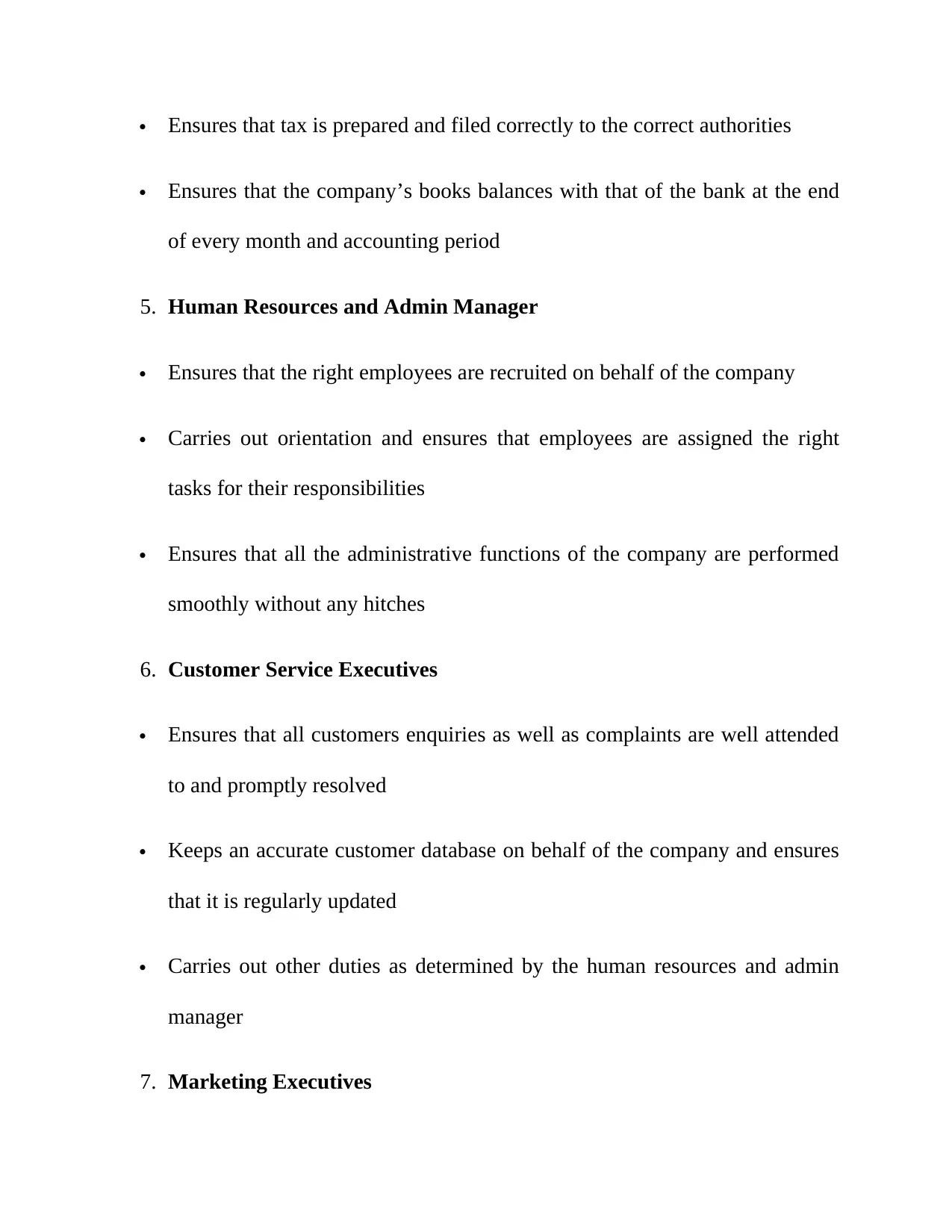
Ensures that tax is prepared and filed correctly to the correct authorities
Ensures that the company’s books balances with that of the bank at the end
of every month and accounting period
5. Human Resources and Admin Manager
Ensures that the right employees are recruited on behalf of the company
Carries out orientation and ensures that employees are assigned the right
tasks for their responsibilities
Ensures that all the administrative functions of the company are performed
smoothly without any hitches
6. Customer Service Executives
Ensures that all customers enquiries as well as complaints are well attended
to and promptly resolved
Keeps an accurate customer database on behalf of the company and ensures
that it is regularly updated
Carries out other duties as determined by the human resources and admin
manager
7. Marketing Executives
Ensures that the company’s books balances with that of the bank at the end
of every month and accounting period
5. Human Resources and Admin Manager
Ensures that the right employees are recruited on behalf of the company
Carries out orientation and ensures that employees are assigned the right
tasks for their responsibilities
Ensures that all the administrative functions of the company are performed
smoothly without any hitches
6. Customer Service Executives
Ensures that all customers enquiries as well as complaints are well attended
to and promptly resolved
Keeps an accurate customer database on behalf of the company and ensures
that it is regularly updated
Carries out other duties as determined by the human resources and admin
manager
7. Marketing Executives
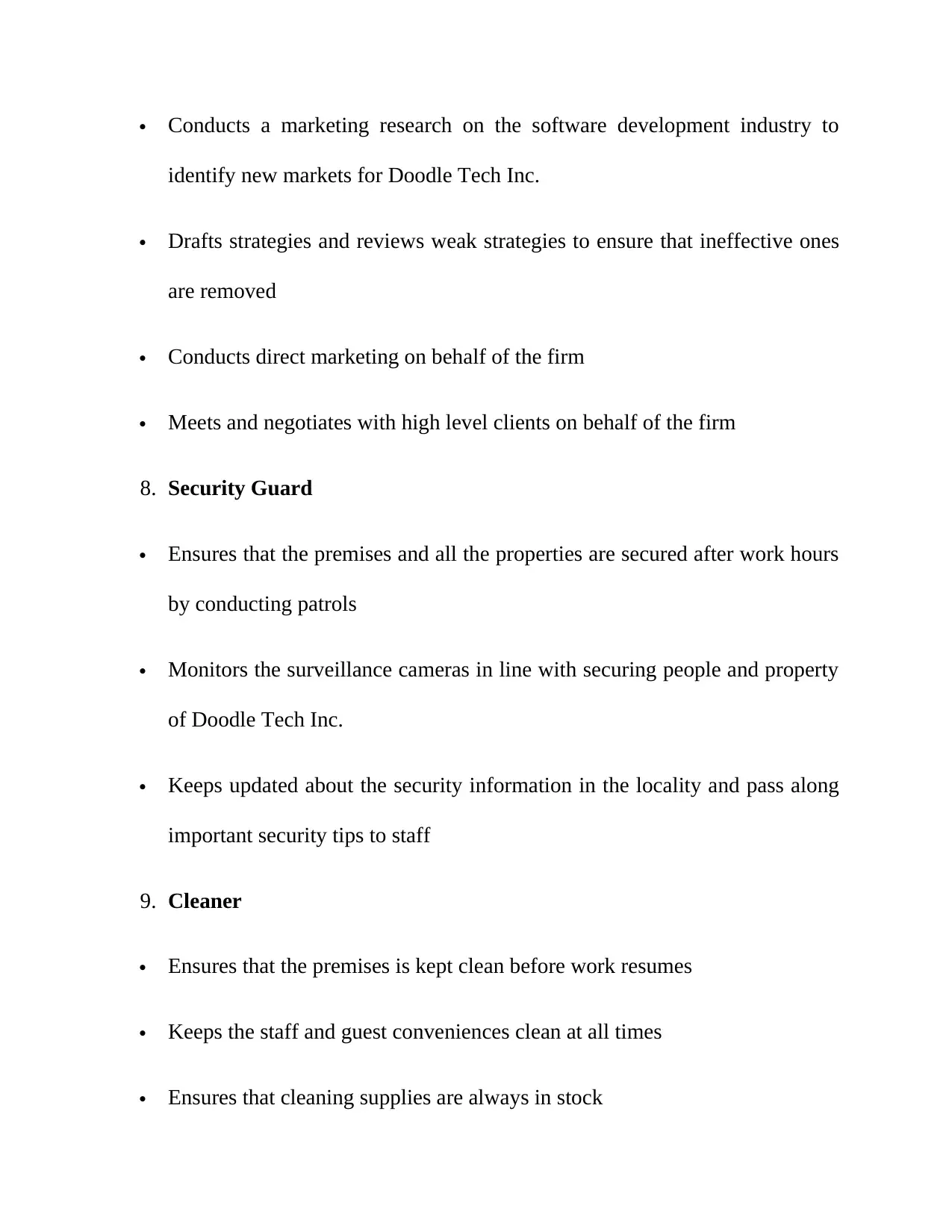
Conducts a marketing research on the software development industry to
identify new markets for Doodle Tech Inc.
Drafts strategies and reviews weak strategies to ensure that ineffective ones
are removed
Conducts direct marketing on behalf of the firm
Meets and negotiates with high level clients on behalf of the firm
8. Security Guard
Ensures that the premises and all the properties are secured after work hours
by conducting patrols
Monitors the surveillance cameras in line with securing people and property
of Doodle Tech Inc.
Keeps updated about the security information in the locality and pass along
important security tips to staff
9. Cleaner
Ensures that the premises is kept clean before work resumes
Keeps the staff and guest conveniences clean at all times
Ensures that cleaning supplies are always in stock
identify new markets for Doodle Tech Inc.
Drafts strategies and reviews weak strategies to ensure that ineffective ones
are removed
Conducts direct marketing on behalf of the firm
Meets and negotiates with high level clients on behalf of the firm
8. Security Guard
Ensures that the premises and all the properties are secured after work hours
by conducting patrols
Monitors the surveillance cameras in line with securing people and property
of Doodle Tech Inc.
Keeps updated about the security information in the locality and pass along
important security tips to staff
9. Cleaner
Ensures that the premises is kept clean before work resumes
Keeps the staff and guest conveniences clean at all times
Ensures that cleaning supplies are always in stock
⊘ This is a preview!⊘
Do you want full access?
Subscribe today to unlock all pages.

Trusted by 1+ million students worldwide
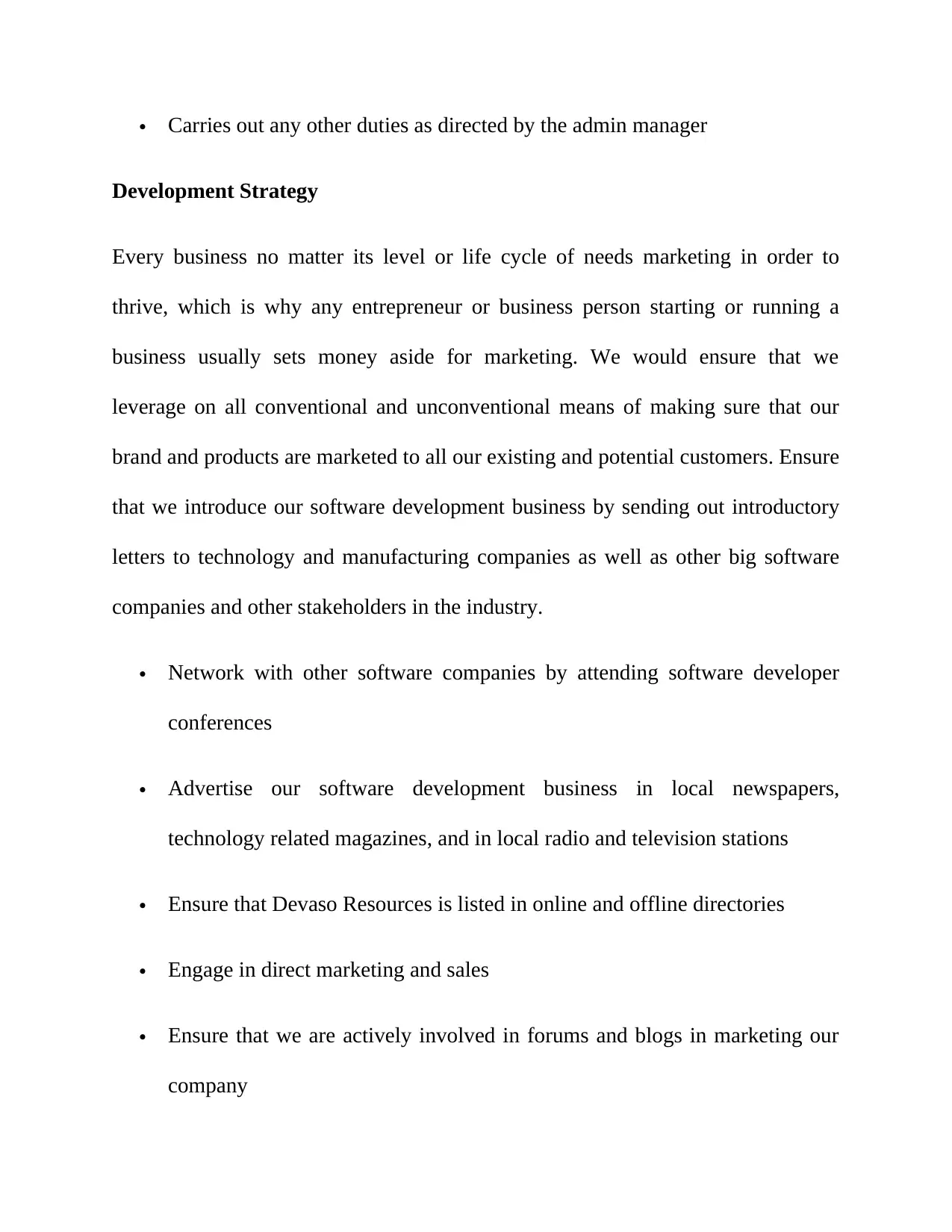
Carries out any other duties as directed by the admin manager
Development Strategy
Every business no matter its level or life cycle of needs marketing in order to
thrive, which is why any entrepreneur or business person starting or running a
business usually sets money aside for marketing. We would ensure that we
leverage on all conventional and unconventional means of making sure that our
brand and products are marketed to all our existing and potential customers. Ensure
that we introduce our software development business by sending out introductory
letters to technology and manufacturing companies as well as other big software
companies and other stakeholders in the industry.
Network with other software companies by attending software developer
conferences
Advertise our software development business in local newspapers,
technology related magazines, and in local radio and television stations
Ensure that Devaso Resources is listed in online and offline directories
Engage in direct marketing and sales
Ensure that we are actively involved in forums and blogs in marketing our
company
Development Strategy
Every business no matter its level or life cycle of needs marketing in order to
thrive, which is why any entrepreneur or business person starting or running a
business usually sets money aside for marketing. We would ensure that we
leverage on all conventional and unconventional means of making sure that our
brand and products are marketed to all our existing and potential customers. Ensure
that we introduce our software development business by sending out introductory
letters to technology and manufacturing companies as well as other big software
companies and other stakeholders in the industry.
Network with other software companies by attending software developer
conferences
Advertise our software development business in local newspapers,
technology related magazines, and in local radio and television stations
Ensure that Devaso Resources is listed in online and offline directories
Engage in direct marketing and sales
Ensure that we are actively involved in forums and blogs in marketing our
company
Paraphrase This Document
Need a fresh take? Get an instant paraphrase of this document with our AI Paraphraser
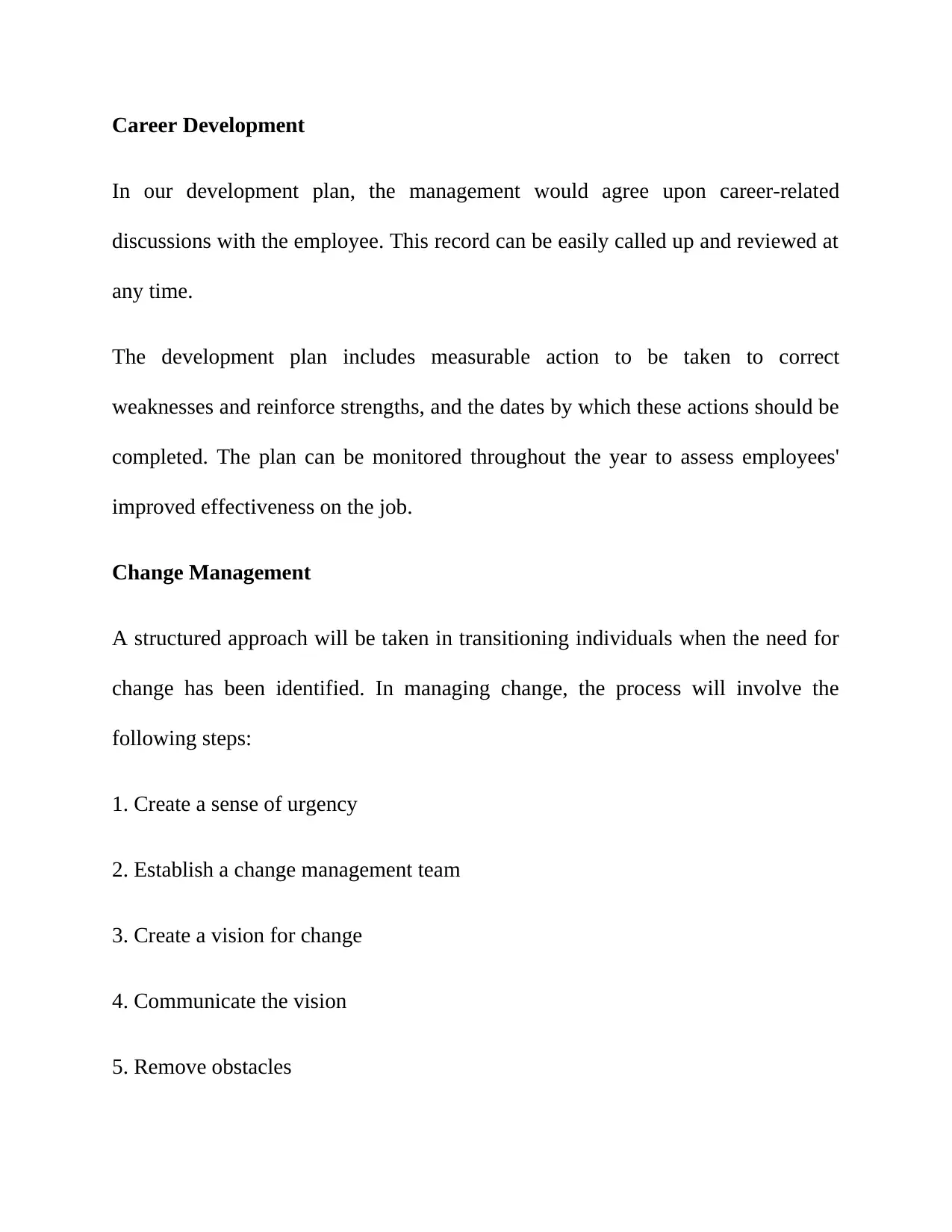
Career Development
In our development plan, the management would agree upon career-related
discussions with the employee. This record can be easily called up and reviewed at
any time.
The development plan includes measurable action to be taken to correct
weaknesses and reinforce strengths, and the dates by which these actions should be
completed. The plan can be monitored throughout the year to assess employees'
improved effectiveness on the job.
Change Management
A structured approach will be taken in transitioning individuals when the need for
change has been identified. In managing change, the process will involve the
following steps:
1. Create a sense of urgency
2. Establish a change management team
3. Create a vision for change
4. Communicate the vision
5. Remove obstacles
In our development plan, the management would agree upon career-related
discussions with the employee. This record can be easily called up and reviewed at
any time.
The development plan includes measurable action to be taken to correct
weaknesses and reinforce strengths, and the dates by which these actions should be
completed. The plan can be monitored throughout the year to assess employees'
improved effectiveness on the job.
Change Management
A structured approach will be taken in transitioning individuals when the need for
change has been identified. In managing change, the process will involve the
following steps:
1. Create a sense of urgency
2. Establish a change management team
3. Create a vision for change
4. Communicate the vision
5. Remove obstacles
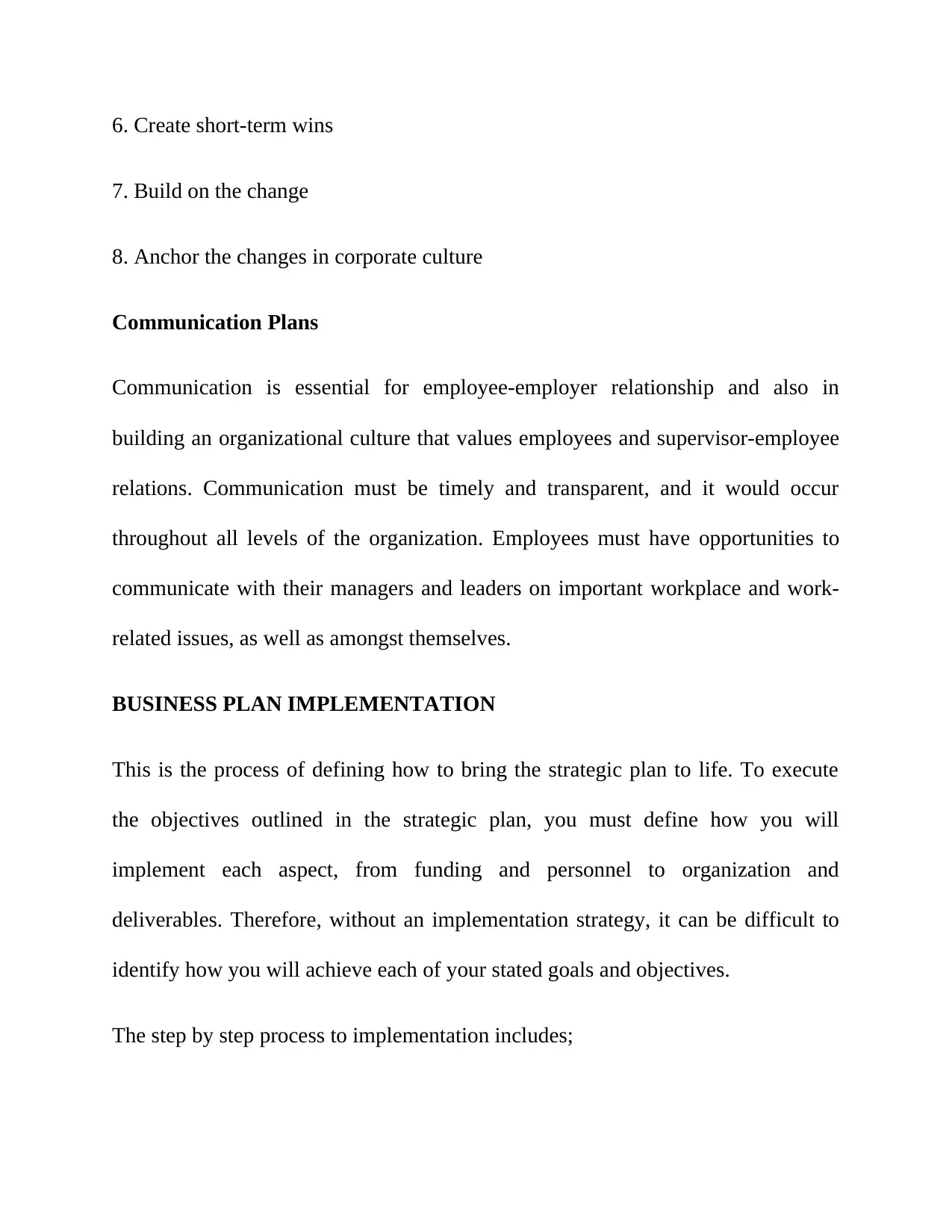
6. Create short-term wins
7. Build on the change
8. Anchor the changes in corporate culture
Communication Plans
Communication is essential for employee-employer relationship and also in
building an organizational culture that values employees and supervisor-employee
relations. Communication must be timely and transparent, and it would occur
throughout all levels of the organization. Employees must have opportunities to
communicate with their managers and leaders on important workplace and work-
related issues, as well as amongst themselves.
BUSINESS PLAN IMPLEMENTATION
This is the process of defining how to bring the strategic plan to life. To execute
the objectives outlined in the strategic plan, you must define how you will
implement each aspect, from funding and personnel to organization and
deliverables. Therefore, without an implementation strategy, it can be difficult to
identify how you will achieve each of your stated goals and objectives.
The step by step process to implementation includes;
7. Build on the change
8. Anchor the changes in corporate culture
Communication Plans
Communication is essential for employee-employer relationship and also in
building an organizational culture that values employees and supervisor-employee
relations. Communication must be timely and transparent, and it would occur
throughout all levels of the organization. Employees must have opportunities to
communicate with their managers and leaders on important workplace and work-
related issues, as well as amongst themselves.
BUSINESS PLAN IMPLEMENTATION
This is the process of defining how to bring the strategic plan to life. To execute
the objectives outlined in the strategic plan, you must define how you will
implement each aspect, from funding and personnel to organization and
deliverables. Therefore, without an implementation strategy, it can be difficult to
identify how you will achieve each of your stated goals and objectives.
The step by step process to implementation includes;
⊘ This is a preview!⊘
Do you want full access?
Subscribe today to unlock all pages.

Trusted by 1+ million students worldwide
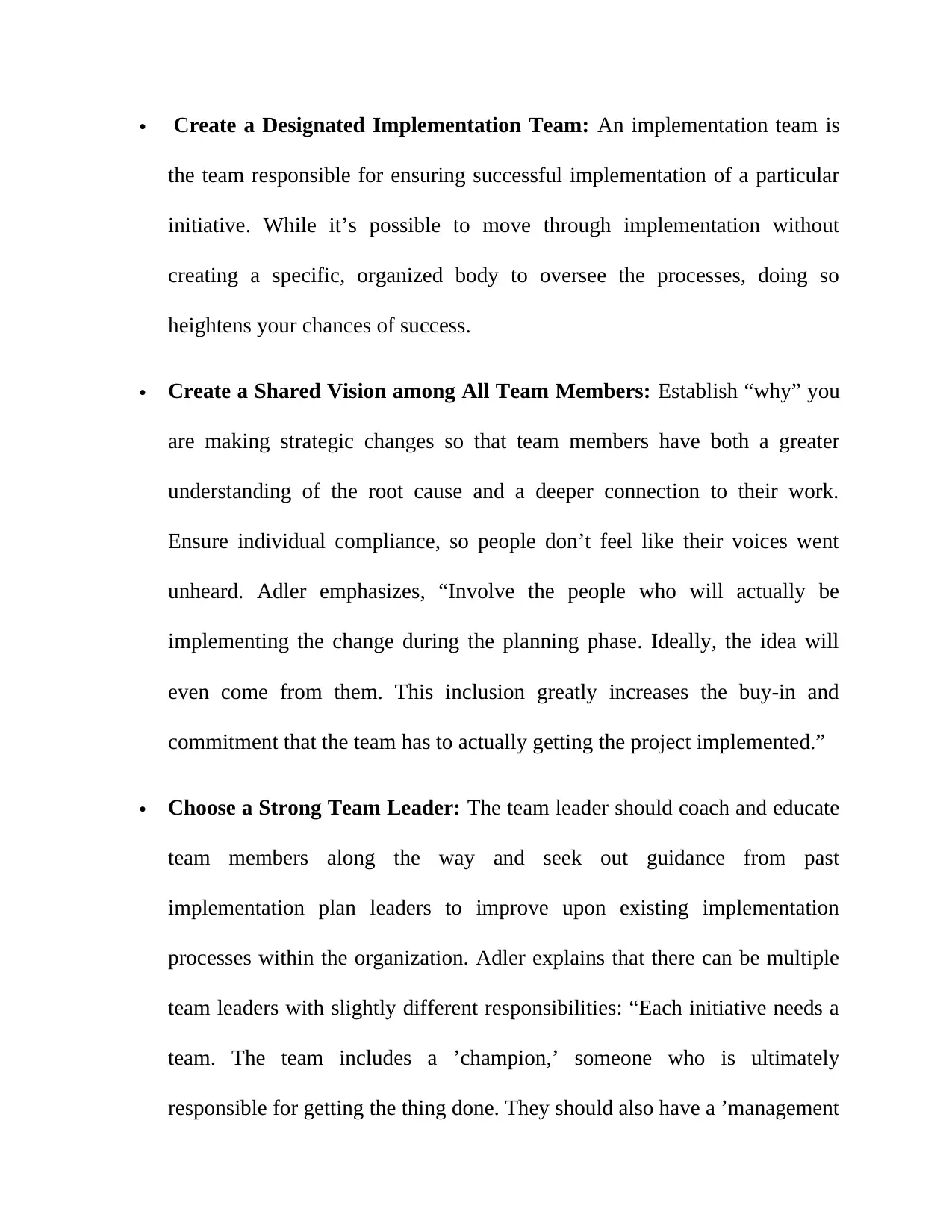
Create a Designated Implementation Team: An implementation team is
the team responsible for ensuring successful implementation of a particular
initiative. While it’s possible to move through implementation without
creating a specific, organized body to oversee the processes, doing so
heightens your chances of success.
Create a Shared Vision among All Team Members: Establish “why” you
are making strategic changes so that team members have both a greater
understanding of the root cause and a deeper connection to their work.
Ensure individual compliance, so people don’t feel like their voices went
unheard. Adler emphasizes, “Involve the people who will actually be
implementing the change during the planning phase. Ideally, the idea will
even come from them. This inclusion greatly increases the buy-in and
commitment that the team has to actually getting the project implemented.”
Choose a Strong Team Leader: The team leader should coach and educate
team members along the way and seek out guidance from past
implementation plan leaders to improve upon existing implementation
processes within the organization. Adler explains that there can be multiple
team leaders with slightly different responsibilities: “Each initiative needs a
team. The team includes a ’champion,’ someone who is ultimately
responsible for getting the thing done. They should also have a ’management
the team responsible for ensuring successful implementation of a particular
initiative. While it’s possible to move through implementation without
creating a specific, organized body to oversee the processes, doing so
heightens your chances of success.
Create a Shared Vision among All Team Members: Establish “why” you
are making strategic changes so that team members have both a greater
understanding of the root cause and a deeper connection to their work.
Ensure individual compliance, so people don’t feel like their voices went
unheard. Adler emphasizes, “Involve the people who will actually be
implementing the change during the planning phase. Ideally, the idea will
even come from them. This inclusion greatly increases the buy-in and
commitment that the team has to actually getting the project implemented.”
Choose a Strong Team Leader: The team leader should coach and educate
team members along the way and seek out guidance from past
implementation plan leaders to improve upon existing implementation
processes within the organization. Adler explains that there can be multiple
team leaders with slightly different responsibilities: “Each initiative needs a
team. The team includes a ’champion,’ someone who is ultimately
responsible for getting the thing done. They should also have a ’management
Paraphrase This Document
Need a fresh take? Get an instant paraphrase of this document with our AI Paraphraser
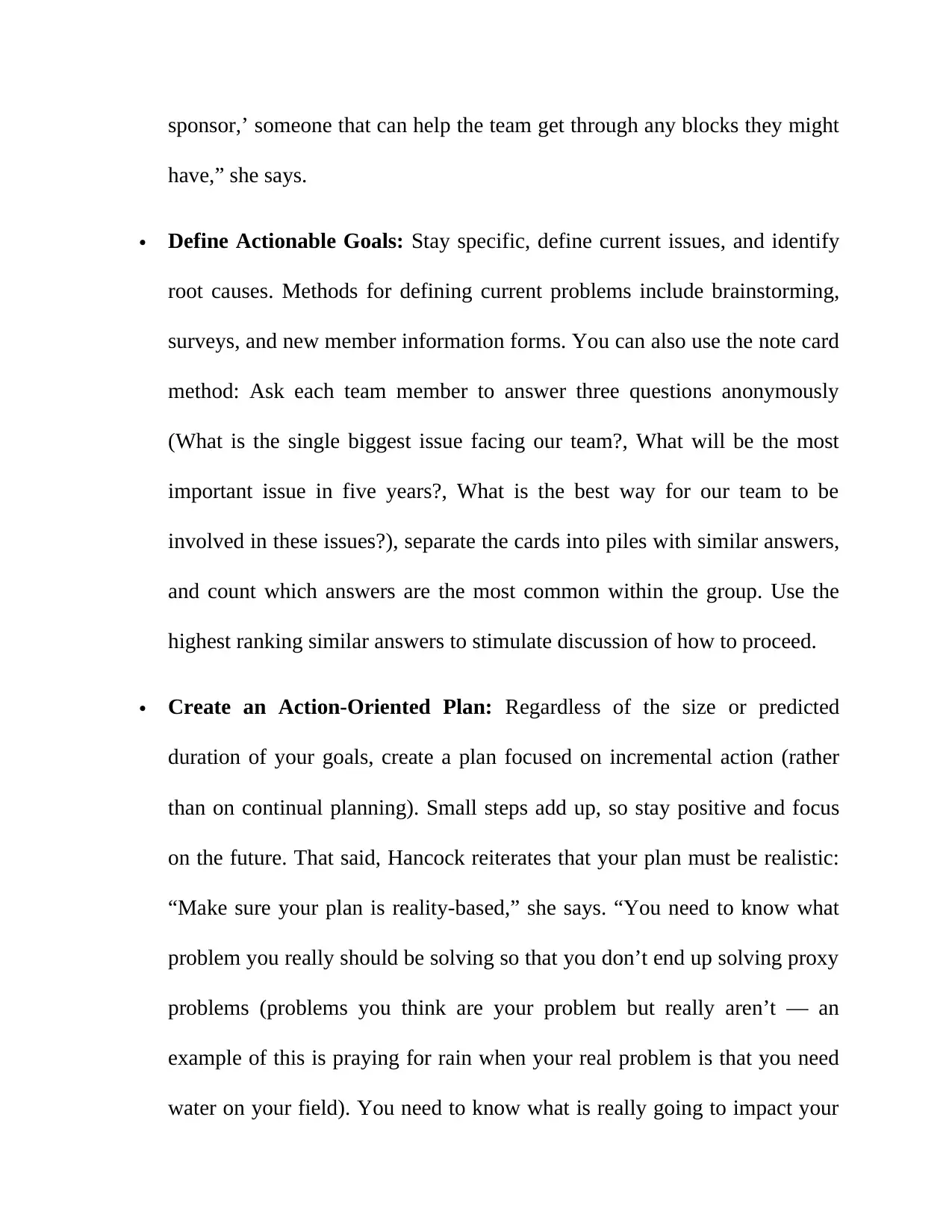
sponsor,’ someone that can help the team get through any blocks they might
have,” she says.
Define Actionable Goals: Stay specific, define current issues, and identify
root causes. Methods for defining current problems include brainstorming,
surveys, and new member information forms. You can also use the note card
method: Ask each team member to answer three questions anonymously
(What is the single biggest issue facing our team?, What will be the most
important issue in five years?, What is the best way for our team to be
involved in these issues?), separate the cards into piles with similar answers,
and count which answers are the most common within the group. Use the
highest ranking similar answers to stimulate discussion of how to proceed.
Create an Action-Oriented Plan: Regardless of the size or predicted
duration of your goals, create a plan focused on incremental action (rather
than on continual planning). Small steps add up, so stay positive and focus
on the future. That said, Hancock reiterates that your plan must be realistic:
“Make sure your plan is reality-based,” she says. “You need to know what
problem you really should be solving so that you don’t end up solving proxy
problems (problems you think are your problem but really aren’t — an
example of this is praying for rain when your real problem is that you need
water on your field). You need to know what is really going to impact your
have,” she says.
Define Actionable Goals: Stay specific, define current issues, and identify
root causes. Methods for defining current problems include brainstorming,
surveys, and new member information forms. You can also use the note card
method: Ask each team member to answer three questions anonymously
(What is the single biggest issue facing our team?, What will be the most
important issue in five years?, What is the best way for our team to be
involved in these issues?), separate the cards into piles with similar answers,
and count which answers are the most common within the group. Use the
highest ranking similar answers to stimulate discussion of how to proceed.
Create an Action-Oriented Plan: Regardless of the size or predicted
duration of your goals, create a plan focused on incremental action (rather
than on continual planning). Small steps add up, so stay positive and focus
on the future. That said, Hancock reiterates that your plan must be realistic:
“Make sure your plan is reality-based,” she says. “You need to know what
problem you really should be solving so that you don’t end up solving proxy
problems (problems you think are your problem but really aren’t — an
example of this is praying for rain when your real problem is that you need
water on your field). You need to know what is really going to impact your
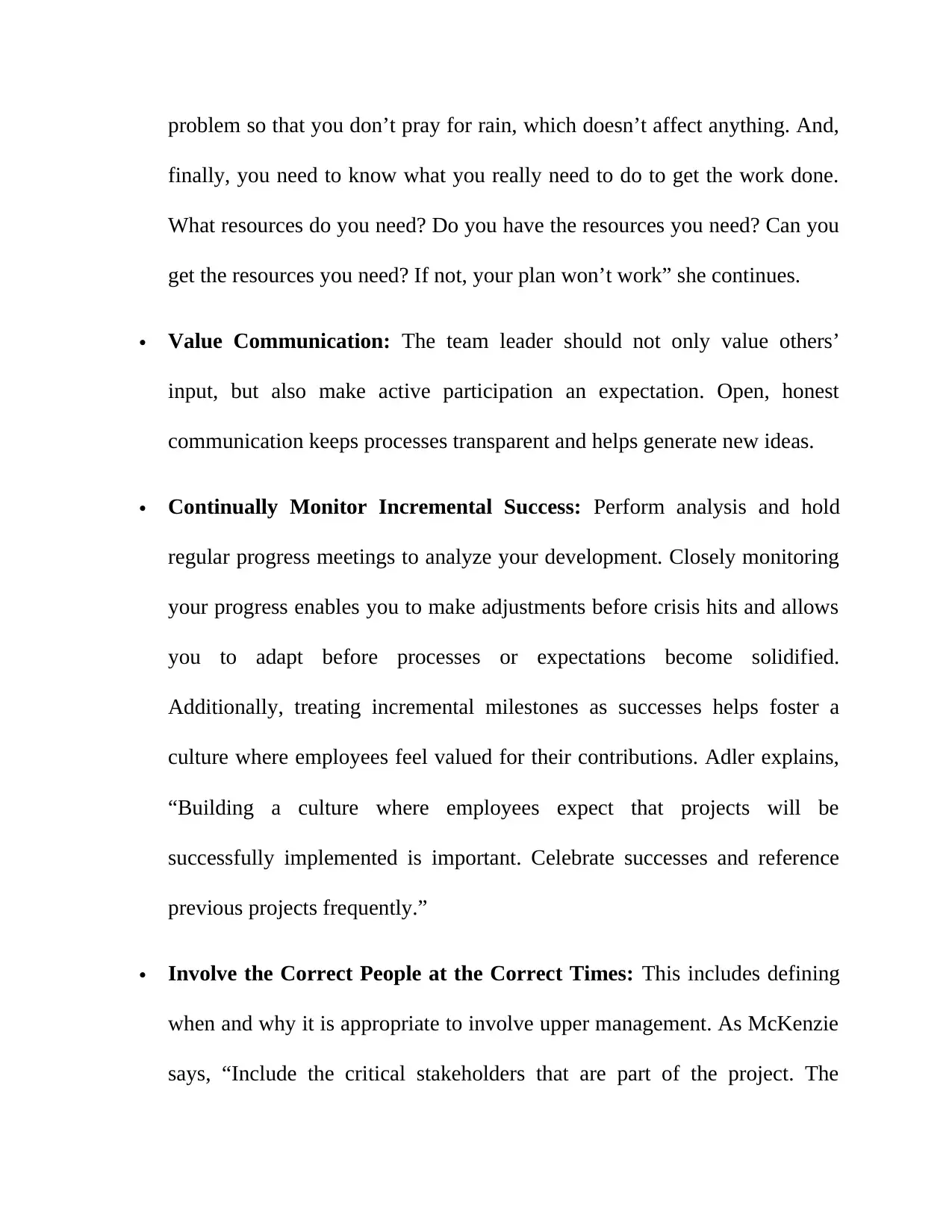
problem so that you don’t pray for rain, which doesn’t affect anything. And,
finally, you need to know what you really need to do to get the work done.
What resources do you need? Do you have the resources you need? Can you
get the resources you need? If not, your plan won’t work” she continues.
Value Communication: The team leader should not only value others’
input, but also make active participation an expectation. Open, honest
communication keeps processes transparent and helps generate new ideas.
Continually Monitor Incremental Success: Perform analysis and hold
regular progress meetings to analyze your development. Closely monitoring
your progress enables you to make adjustments before crisis hits and allows
you to adapt before processes or expectations become solidified.
Additionally, treating incremental milestones as successes helps foster a
culture where employees feel valued for their contributions. Adler explains,
“Building a culture where employees expect that projects will be
successfully implemented is important. Celebrate successes and reference
previous projects frequently.”
Involve the Correct People at the Correct Times: This includes defining
when and why it is appropriate to involve upper management. As McKenzie
says, “Include the critical stakeholders that are part of the project. The
finally, you need to know what you really need to do to get the work done.
What resources do you need? Do you have the resources you need? Can you
get the resources you need? If not, your plan won’t work” she continues.
Value Communication: The team leader should not only value others’
input, but also make active participation an expectation. Open, honest
communication keeps processes transparent and helps generate new ideas.
Continually Monitor Incremental Success: Perform analysis and hold
regular progress meetings to analyze your development. Closely monitoring
your progress enables you to make adjustments before crisis hits and allows
you to adapt before processes or expectations become solidified.
Additionally, treating incremental milestones as successes helps foster a
culture where employees feel valued for their contributions. Adler explains,
“Building a culture where employees expect that projects will be
successfully implemented is important. Celebrate successes and reference
previous projects frequently.”
Involve the Correct People at the Correct Times: This includes defining
when and why it is appropriate to involve upper management. As McKenzie
says, “Include the critical stakeholders that are part of the project. The
⊘ This is a preview!⊘
Do you want full access?
Subscribe today to unlock all pages.

Trusted by 1+ million students worldwide
1 out of 13
Related Documents
Your All-in-One AI-Powered Toolkit for Academic Success.
+13062052269
info@desklib.com
Available 24*7 on WhatsApp / Email
![[object Object]](/_next/static/media/star-bottom.7253800d.svg)
Unlock your academic potential
Copyright © 2020–2025 A2Z Services. All Rights Reserved. Developed and managed by ZUCOL.





